“Given the scientific evidence that I have examined, I’m convinced there’s a creature out there that is yet to be identified.”—Jeff Meldrum, Professor of Anthropology, Idaho State University
 In 2004, nearly 40 years after the Patterson-Gomlin film was shot, a man named Bob Heironimus, also a resident of Yakima, Washington and a casual acquaintance of both Roger Patterson and Bob Gimlin, stepped into the spotlight by claiming that he was the one wearing the gorilla suit in the famous video. (Actually, a number of people have obtained a short-lived measure of notoriety over the years by claiming that they were the one in the suit, but none of them could come up with an even mildly convincing story as to how that had come about. At least Heironimus could verify that he knew Patterson and Gimlin.) He originally claimed that the suit had been made from the hide of a horse that Patterson had killed for the sole purpose of making a costume out of it. He later changed his story and said that it had been made by John Chambers, the costume designer for the original Planet of the Apes movies.* It would seem that at this point he hadn’t heard the claim made by Philip Morris of North Carolina’s Morris Costumes in which he stated that he had sold a gorilla costume that he made to Patterson in 1967. That would change, and the two of them would later team up to affirm that Heironimus had worn the custom gorilla costume that Morris had created. Unfortunately for them, they have never been able to get their stories straight, and the resulting inconsistencies leave a hole in their allegations big enough for the Loch Ness Monster to swim through. In fact, one Bigfoot enthusiast that I’m aware of has refuted Heironimus to within an inch of his life. He really doesn’t like that guy.
In 2004, nearly 40 years after the Patterson-Gomlin film was shot, a man named Bob Heironimus, also a resident of Yakima, Washington and a casual acquaintance of both Roger Patterson and Bob Gimlin, stepped into the spotlight by claiming that he was the one wearing the gorilla suit in the famous video. (Actually, a number of people have obtained a short-lived measure of notoriety over the years by claiming that they were the one in the suit, but none of them could come up with an even mildly convincing story as to how that had come about. At least Heironimus could verify that he knew Patterson and Gimlin.) He originally claimed that the suit had been made from the hide of a horse that Patterson had killed for the sole purpose of making a costume out of it. He later changed his story and said that it had been made by John Chambers, the costume designer for the original Planet of the Apes movies.* It would seem that at this point he hadn’t heard the claim made by Philip Morris of North Carolina’s Morris Costumes in which he stated that he had sold a gorilla costume that he made to Patterson in 1967. That would change, and the two of them would later team up to affirm that Heironimus had worn the custom gorilla costume that Morris had created. Unfortunately for them, they have never been able to get their stories straight, and the resulting inconsistencies leave a hole in their allegations big enough for the Loch Ness Monster to swim through. In fact, one Bigfoot enthusiast that I’m aware of has refuted Heironimus to within an inch of his life. He really doesn’t like that guy.
Naturally, the first problem is that Heironimus initially claimed that Patterson made the costume himself from horse hide. Conversely, Morris said that it had been made from a synthetic fur that was commonly used in the 1960s. Perhaps Patterson had lied to him about where the suit came from, but why would you lie about killing a horse just to make a Bigfoot costume out of it? And even a city boy like me should be able to tell the difference between horse hide and cheap synthetic fur.
They also gave contradictory details about the construction of the suit. One said that it was a two-piece outfit (bodysuit and mask) with a zipper in the back, while the other stated that it was a three-piece (separate top and bottom with a mask) and that the top zipped up in the front. These are some fairly important discrepancies, not to mention the fact that even some analysts who believe that the film is a hoax have commented that there is no evident seam around the neck area to indicate that a mask was worn, and no one has yet found any evidence of a zipper.
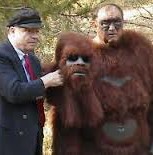 For some reason, Morris then made a much more elaborate costume that resembled the creature in the film and said that it was a re-creation of the costume that he had sold to Patterson, despite his original claim that he had sold him a simple gorilla suit. He had also earlier claimed that Patterson had phoned him to ask how to make certain modifications to the outfit to make it a more convincing fraud. Patterson would likely have had no need to make alterations if this later costume was an accurate reproduction of the first.
For some reason, Morris then made a much more elaborate costume that resembled the creature in the film and said that it was a re-creation of the costume that he had sold to Patterson, despite his original claim that he had sold him a simple gorilla suit. He had also earlier claimed that Patterson had phoned him to ask how to make certain modifications to the outfit to make it a more convincing fraud. Patterson would likely have had no need to make alterations if this later costume was an accurate reproduction of the first.
Before moving on with the Heironimus-Morris version of the events, we need to revisit the unusual gait of the figure in the video. Although it isn’t that obvious unless you’re looking for it, you can clearly see in parts of the footage that the being’s non-weight-bearing foot comes well off the ground. Close examinations of the creature have shown that it bends its leg to about a 70° angle. Humans bend their legs to about a 50° angle when we walk, and our non-weight-bearing foot barely leaves the ground (pre-swing phase). If you’re wondering why this is a big deal, try walking by lifting your back foot about eight inches off the ground, just high enough to where someone behind you would be able to see the bottom of your shoe, and you’ll see how unnatural this feels. And no lifting your knees up in the air. The figure in the film wasn’t marching. Your foot has to come up behind you, as if you’re making a very half-hearted attempt to kick yourself in the butt. Now try it while taking much longer steps than usual. I tried this in a parking lot, and people were looking at me like I was crazy (the fact that I am notwithstanding). This also results in a flat-footed style of walking which is consistent with various footprints that have been found.
It turns out that this is why the previously mysterious (at least to me) importance of the frame speed setting of the camera is so crucial. A slower frame speed would mean that the creature was moving at a faster pace, and it would be extremely difficult, if not impossible, for a human to move that quickly and with such long strides while walking in such an unusual fashion. Just trying to walk like that at any speed is quite a workout. I still had a little twinge in my calves several hours after my stroll through the parking lot.
If you actually tried walking like this, the first question that should come to mind is why a person in an ape suit would do this if they were planning a hoax. No primate species walks like this, and it’s extremely awkward, which brings us back to Heironimus and Morris. Heironimus has been filmed 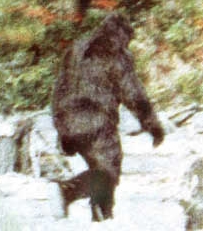 demonstrating his Bigfoot walk both with and without the new and improved costume. He’s got the arm swing, the head turn, and even the long stride down pat, but his back foot barely comes off the ground. If he was the one in the film, one might think that he would have remembered walking in such an unusual manner. In fact, he’s never even mentioned this, in all likelihood because that wasn’t him. None of this proves that the creature wasn’t a man in a costume, but it does make it seem unlikely that these two jokers had anything to do with it. So if not them, then who? No one credible has ever stepped forward to answer that question.
demonstrating his Bigfoot walk both with and without the new and improved costume. He’s got the arm swing, the head turn, and even the long stride down pat, but his back foot barely comes off the ground. If he was the one in the film, one might think that he would have remembered walking in such an unusual manner. In fact, he’s never even mentioned this, in all likelihood because that wasn’t him. None of this proves that the creature wasn’t a man in a costume, but it does make it seem unlikely that these two jokers had anything to do with it. So if not them, then who? No one credible has ever stepped forward to answer that question.
So what would be their motivation for concocting such a story after more than three decades? According to Heironimus, it was because he had finally grown tired of not getting his cut of all of the money that Patterson and Gimlin had made from the film. (Actually, Patterson never made that much from the video, and Gimlin says that he never got a dime.) He must be a very patient man to have waited 37 years for the $1,000 he says that Patterson had promised him, especially since he died in 1972. Morris said that he was just tired of being part of a hoax, but what took so long? Did his conscience really not bother him for 35 years? He says that he didn’t say anything because he’s in show business and that revealing a client’s secrets would have damaged his business and his reputation. In fairness, he does claim to have worked with a number of stage magicians, and they hate having their secrets given away.
In the end, Mr. Morris would like for us to believe his story without any proof on the grounds that he is sincere, which is something that the cynics have never been willing to do, and for good reason in some cases. He says that he got tired of being complicit in an elaborate hoax, but he could have saved everyone a lot of trouble if he had come forward back when he would have presumably had some kind of evidence to back up his claim. No cynic would ever give any witness anywhere near that kind of latitude, nor should they. At least Heironimus was honest enough to admit in an interview that he was just looking for a payday.
And with that less than perfect segue, let’s take a look at what the legitimate pranksters (aka special effects artists) have to say about the matter.
John Chambers, the aforementioned costume designer for the Planet of the Apes movies said in a 1997 interview that he could never have created a costume that good. After viewing the film, Hollywood costume designer Janos Prohaska said that he was convinced of its authenticity. He further stated that if it was a hoax, then it was remarkably sophisticated and had the best costume that he had ever seen. During an interview in 1969, Disney executive Ken Peterson expressed his doubt that his people would be able to duplicate the film. Peter Brooke, Creative Supervisor for Jim Henson’s Creature Shop, said “If this is a hoax…it’s one of the great practical jokes of all time.”
By far the most in-depth analysis done by someone in showbiz was that of computer animator and creature costume designer Bill Munns. In 2009, he did a frame by frame computer enhancement and analysis of a first generation copy of the original film which was provided by Patricia Patterson (Roger’s widow). Without going into too much detail, the crux of his findings are based on the location of certain joints and their relationship to each other because a costume can’t change these. What he found was that the creature’s knees are significantly lower down the leg than a human’s, meaning that 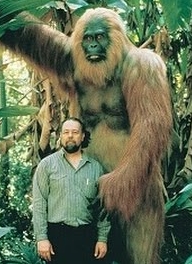 if you align the location of the knees with those of a same sized human, then the location of the hips and shoulders are off. Likewise, if you match up the location of the hips or shoulders, then the location of the other joints don’t match up. He concluded that the creature in the film has much longer upper legs and shorter lower legs than a human based on the location of the hip and knee joints. Also, its torso and arms are longer, and its hips lower than those of a human. Bottom line: if this was a man in a suit, he is one weird looking dude. And based on the findings of several independent analyses, the creature in the film is at least 6’ 6” and probably closer to 7’ 6” tall. So far, no human resembling such a tall and oddly proportioned individual has been located. Also, he would probably have a really weird walk.
if you align the location of the knees with those of a same sized human, then the location of the hips and shoulders are off. Likewise, if you match up the location of the hips or shoulders, then the location of the other joints don’t match up. He concluded that the creature in the film has much longer upper legs and shorter lower legs than a human based on the location of the hip and knee joints. Also, its torso and arms are longer, and its hips lower than those of a human. Bottom line: if this was a man in a suit, he is one weird looking dude. And based on the findings of several independent analyses, the creature in the film is at least 6’ 6” and probably closer to 7’ 6” tall. So far, no human resembling such a tall and oddly proportioned individual has been located. Also, he would probably have a really weird walk.
The only dissenting opinion that I’ve found amongst the Hollywood types that the film is at the very least an impressive hoax is that of Academy Award winning effects and makeup artist Stan Winston, who said “It’s a guy in a bad hair suit. Sorry.” That’s quite a far cry (and a smug one at that) from the opinions of his peers. Am I grasping at straws when I suggest that a possible reason for the discrepancy between his and his colleague’s opinions might have been professional jealousy, possibly directed at one particular individual? For years, people in the Hollywood special effects community thought that John Chambers had created the costume (see footnote below). Perhaps Winston was taking a thinly veiled shot at the talents of one of his rivals when he made that statement. Maybe. Show business is a petty business.
And incidentally, the “father of cryptozoology” Bernard Heuvalmans also summarily dismissed it as being nothing more than a man in a suit. Perhaps another case of sour grapes that a couple of cowboys were able to make a greater contribution to his own field than he ever was? Again, maybe. Certainly other knowledgeable people who also believe that the film is a fake have been far more complimentary and much less condescending than these two.
So there’s a look at two different kinds of frauds: those who lie and impugn the integrity of others while trying to take credit where none is due, and those who make a living creating illusions for our amusement. I much prefer the latter. They provide us with a much more benevolent form of deception. So what are we to make of Roger Patterson and Bob Gimlin? Most of the professional myth makers regard them as being either honest monster hunters who got extremely lucky or very unusual and talented members of their creature feature, movie magic fraternity, albeit ones of a somewhat rogue variety. In the spirit of this ambiguity, I’ll leave you with a pair of rather backhanded compliments from anthropologist David Daegling – one regarding the possibility that the film is a clever fake, and the other a reason to believe that it could be real.
“It is not unreasonable to suggest that it is better than some of the tackier monster outfits that got thrown together for television at that time,” and “Most acquaintances of Patterson volunteered that neither he nor Gimlin were clever enough to put something that detailed together.”
______________________________________________________________________________________
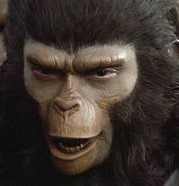 *There are still a few who maintain that Chambers did create the costume in the film, despite the fact that he said in a 1997 interview that he had nothing to do with it. He also admitted that he had never previously denied (and had probably encouraged) rumors that he had created it because he said that it was better than any costume that he was capable of making, but he enjoyed people thinking that he had. For three decades, it was a widely held belief in the Hollywood special effects community that Chambers was the man behind the Patterson-Gimlin film. Some still reject his 1997 confession and cling doggedly to the belief that Chambers was the one responsible for the hoax.
*There are still a few who maintain that Chambers did create the costume in the film, despite the fact that he said in a 1997 interview that he had nothing to do with it. He also admitted that he had never previously denied (and had probably encouraged) rumors that he had created it because he said that it was better than any costume that he was capable of making, but he enjoyed people thinking that he had. For three decades, it was a widely held belief in the Hollywood special effects community that Chambers was the man behind the Patterson-Gimlin film. Some still reject his 1997 confession and cling doggedly to the belief that Chambers was the one responsible for the hoax.


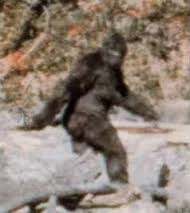 Most of you have probably seen the Patterson-Gimlin Bigfoot video. You might not know that this is what it’s called, but you’ve seen it. I first saw it when I was seven, and it was one of the things that spurred my interest in the paranormal from such an early age. In fact, it was the most influential because something that you can actually see with your own two eyes is far more convincing than anything that you read or have been told. I still believed in Santa Claus at the time (and still do), so the reality of this thing which had been captured on film was something that I never doubted. I was too young and naïve to even consider the possibility that it could be a fraud. Adults weren’t supposed to lie. Now that I am an adult, I’m not entirely convinced.
Most of you have probably seen the Patterson-Gimlin Bigfoot video. You might not know that this is what it’s called, but you’ve seen it. I first saw it when I was seven, and it was one of the things that spurred my interest in the paranormal from such an early age. In fact, it was the most influential because something that you can actually see with your own two eyes is far more convincing than anything that you read or have been told. I still believed in Santa Claus at the time (and still do), so the reality of this thing which had been captured on film was something that I never doubted. I was too young and naïve to even consider the possibility that it could be a fraud. Adults weren’t supposed to lie. Now that I am an adult, I’m not entirely convinced. According to Patterson and Gimlin, in the early afternoon of October 20, 1967, they were riding along Bluff Creek on horseback when they came upon a large, uprooted tree that had fallen at a bend in the creek. As they rounded the tree, they first saw the creature kneeling by the creek. They estimated it to be about 25 feet away from them. Patterson said that it took him about 20 seconds to dismount and retrieve the camera from his saddlebag. By this time, the creature had moved to about 120 feet away, and Patterson began chasing after it, filming the whole time. He stopped when he got around 80 feet away, which is when the film gets good because until then you really can’t see much. The thing can clearly be seen turning its head to look back at Patterson over its shoulder at this point. Its expression was one that Patterson later described as being that of “contempt and disgust.” I mention this primarily because I think it’s an interesting detail, although I seem to be the only one. Why would this creature have reacted to them in that way? It sounds like a celebrity showing her disdain for members of the paparazzi. If the story was made up, why would Patterson have chosen to include such an inexplicable detail?
According to Patterson and Gimlin, in the early afternoon of October 20, 1967, they were riding along Bluff Creek on horseback when they came upon a large, uprooted tree that had fallen at a bend in the creek. As they rounded the tree, they first saw the creature kneeling by the creek. They estimated it to be about 25 feet away from them. Patterson said that it took him about 20 seconds to dismount and retrieve the camera from his saddlebag. By this time, the creature had moved to about 120 feet away, and Patterson began chasing after it, filming the whole time. He stopped when he got around 80 feet away, which is when the film gets good because until then you really can’t see much. The thing can clearly be seen turning its head to look back at Patterson over its shoulder at this point. Its expression was one that Patterson later described as being that of “contempt and disgust.” I mention this primarily because I think it’s an interesting detail, although I seem to be the only one. Why would this creature have reacted to them in that way? It sounds like a celebrity showing her disdain for members of the paparazzi. If the story was made up, why would Patterson have chosen to include such an inexplicable detail?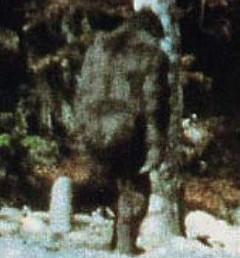 Another analysis was done by anthropologist Grover Krantz in 1972. He also concluded that the creature’s unusually wide shoulders could not be faked using some sort of padding without altering the natural range of motion shown in the film. In addition, he noted that the creature’s ankles were set further forward from the heel than a human’s, and that the distinctly visible musculature would be very difficult to fake. He interviewed Patterson and came to the conclusion that he lacked the skill and knowledge to have produced such a convincing hoax.
Another analysis was done by anthropologist Grover Krantz in 1972. He also concluded that the creature’s unusually wide shoulders could not be faked using some sort of padding without altering the natural range of motion shown in the film. In addition, he noted that the creature’s ankles were set further forward from the heel than a human’s, and that the distinctly visible musculature would be very difficult to fake. He interviewed Patterson and came to the conclusion that he lacked the skill and knowledge to have produced such a convincing hoax.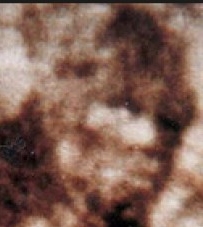 witnesses who have reported seeing Bigfoot at close range is how oddly human its face is, even while it is so obviously not human. Looking at closeups from the Patterson-Gimlin film, I’m struck by the same thing, albeit I’m certain to a much lesser degree. I can’t profess to knowing anything about the intricacies of film speed or primate locomotor characteristics, but I do know a face when I see one. And this one, by the way, doesn’t look anything like the guy who later claimed to be the one in the “gorilla suit,” but we’ll get to that next week.
witnesses who have reported seeing Bigfoot at close range is how oddly human its face is, even while it is so obviously not human. Looking at closeups from the Patterson-Gimlin film, I’m struck by the same thing, albeit I’m certain to a much lesser degree. I can’t profess to knowing anything about the intricacies of film speed or primate locomotor characteristics, but I do know a face when I see one. And this one, by the way, doesn’t look anything like the guy who later claimed to be the one in the “gorilla suit,” but we’ll get to that next week.